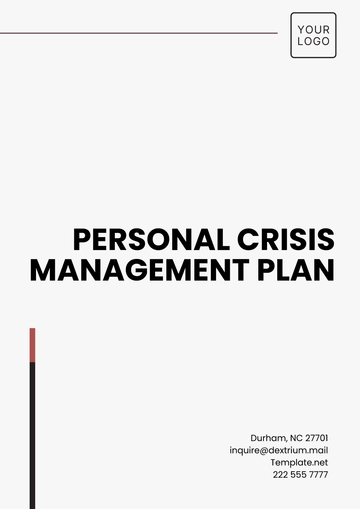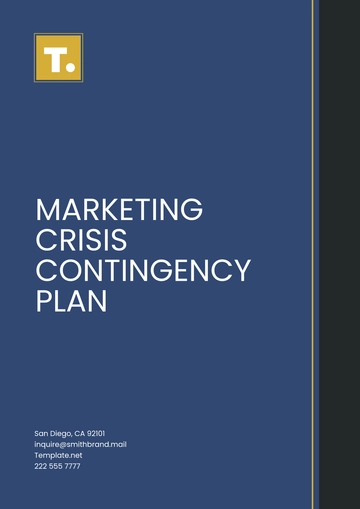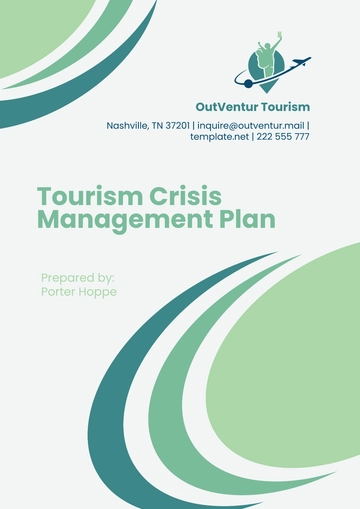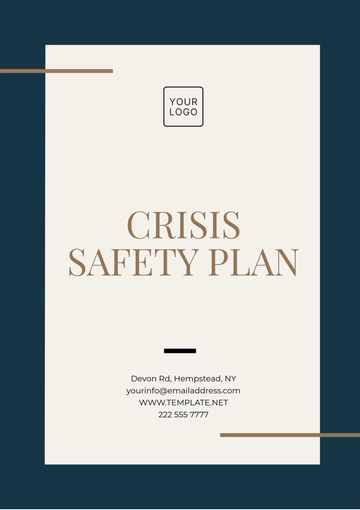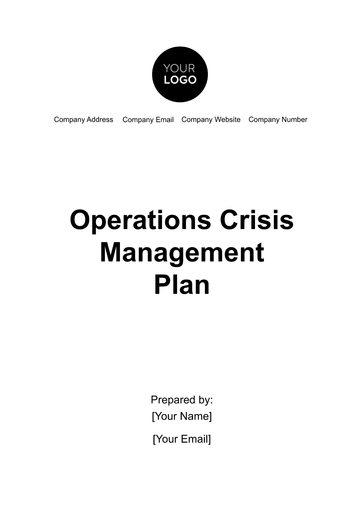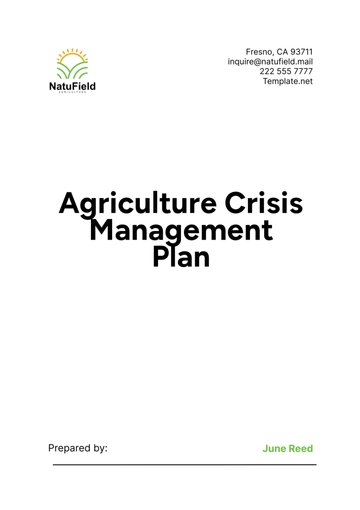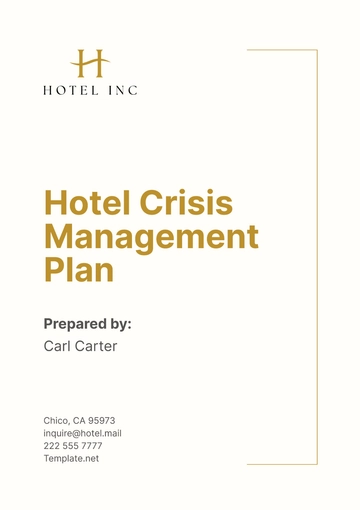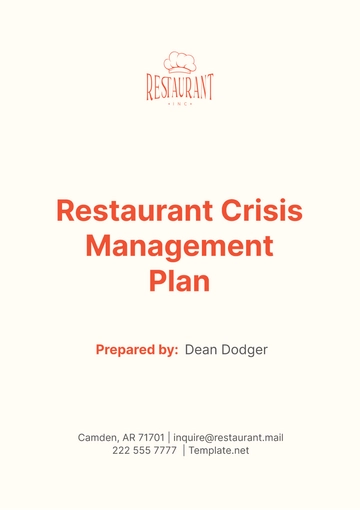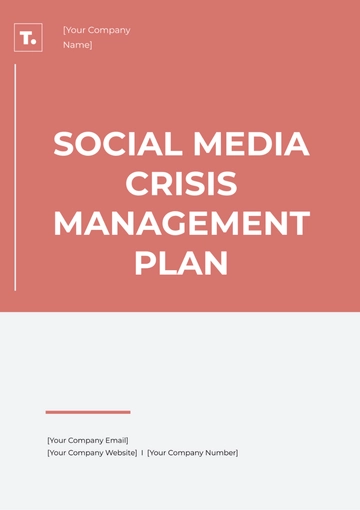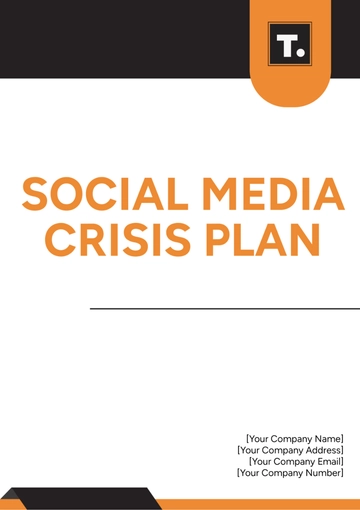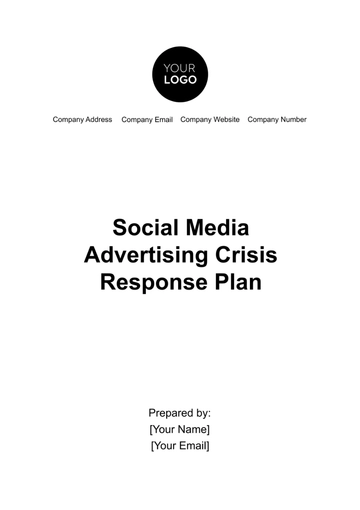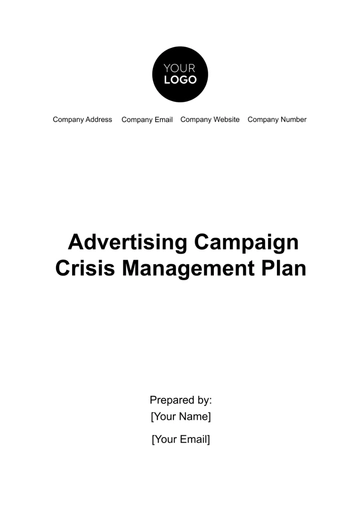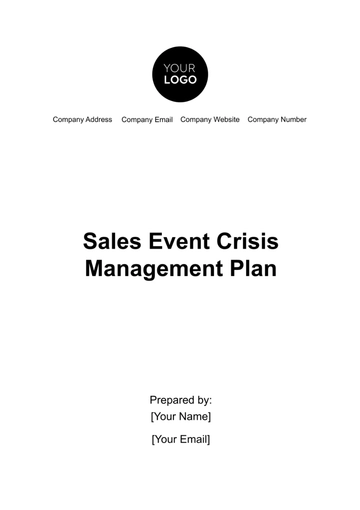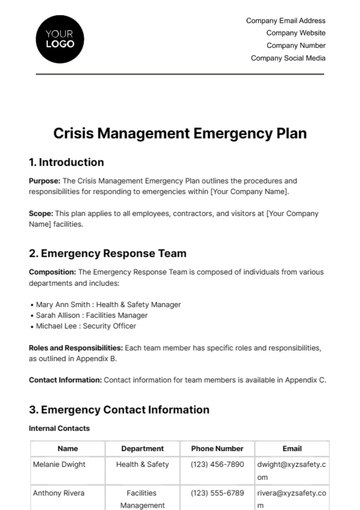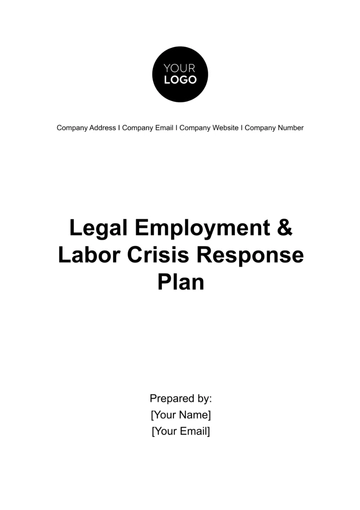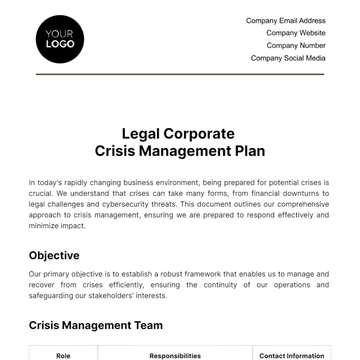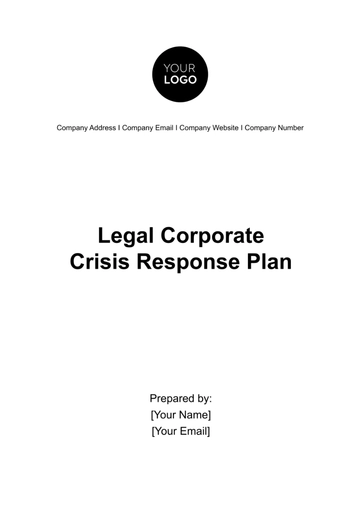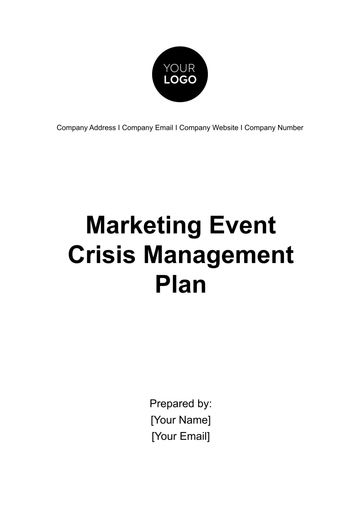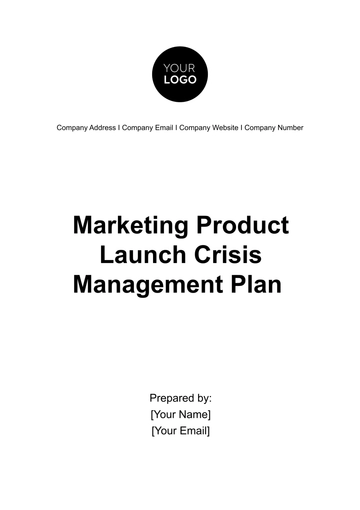Free Restaurant Crisis Management Plan
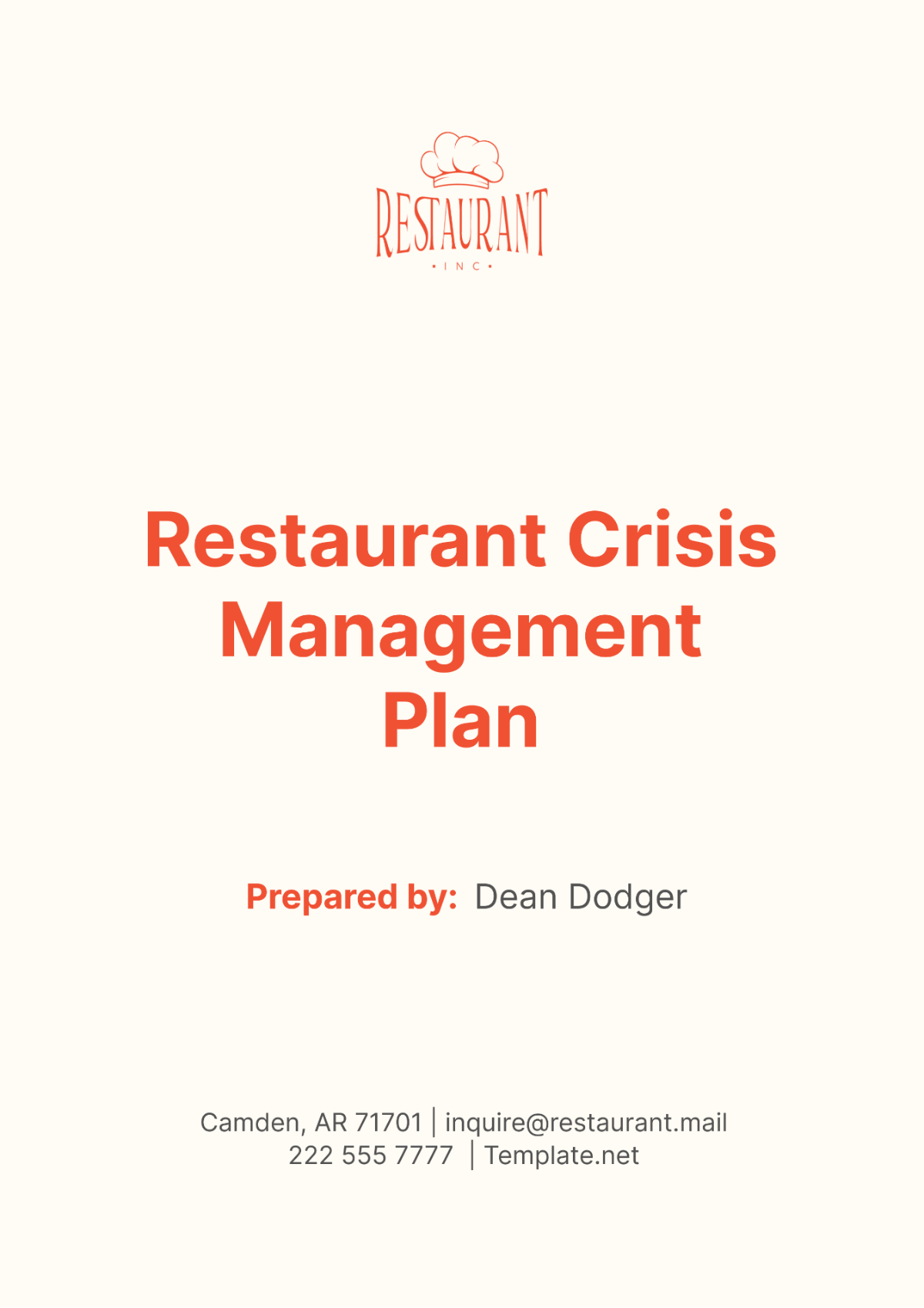
I. Introduction
A. Objectives
The primary objectives of this plan are manifold:
Protection of Staff and Customers: Our top priority is ensuring the health and safety of our staff and customers. We are committed to creating a safe environment where everyone can feel secure. This includes implementing strict health and safety protocols and providing regular training to our staff.
Effective Communication: Maintaining clear and effective communication during crises is crucial. We believe in the power of transparency and will keep all stakeholders informed about the situation and the steps we are taking to manage it.
Operational Continuity: Minimizing operational disruptions is key to maintaining service quality and customer satisfaction. We have contingency plans in place to ensure that we can continue to serve our customers even in the face of a crisis.
Reputation Management: Safeguarding the restaurant’s reputation by managing the crisis effectively and transparently is of utmost importance. We understand that how we handle a crisis can significantly impact our reputation, and we are committed to handling every situation with integrity and professionalism.
Efficient Recovery: Ensuring a quick and efficient recovery to normal operations post-crisis is essential. We have recovery plans in place that are designed to help us resume normal operations as quickly as possible after a crisis.
B. Scope
This plan is comprehensive and applies to all types of crises that could potentially disrupt the normal operations of [Your Company Name]. This includes, but is not limited to:
Natural Disasters: These include events such as earthquakes, floods, and storms that can cause significant damage and disruption.
Health Pandemics: In the event of a health pandemic, we have plans in place to ensure the safety of our staff and customers while continuing to provide our services.
Food Poisoning Incidents: We adhere to strict food safety and hygiene standards to prevent food poisoning incidents. However, should such an incident occur, we have procedures in place to handle it effectively.
Fire Hazards: Fire safety is a top priority, and we have measures in place to prevent and respond to fire hazards.
Other Emergencies: This includes any other situations that may disrupt the normal operations of [Your Company Name], such as power outages or equipment failures. We have contingency plans in place for a wide range of potential emergencies.
II. Responsibilities
In the event of a crisis, it is crucial to have a clear understanding of the roles and responsibilities of each member of the team. This ensures that everyone knows what they need to do and can act quickly and efficiently.
A. Restaurant Manager
Coordination: During a crisis, coordinating efforts across all departments is a key responsibility. This involves ensuring that all teams are working together effectively and that resources are being used efficiently.
Decision Making: As the leader of the team, making final decisions during a crisis is a crucial role. These decisions could involve anything from resource allocation to communication strategies.
Plan Execution: Ensuring that the crisis management plan is executed effectively is another important responsibility. This involves monitoring the situation, adjusting the plan as necessary, and ensuring that all team members are carrying out their responsibilities.
B. Head Chef
Kitchen Safety: Ensuring kitchen safety during a crisis is a key responsibility. This involves implementing and enforcing safety protocols, and ensuring that all kitchen staff are aware of and following these protocols.
Food Preparation: Overseeing the cooking process to maintain the quality of food and service is another important role. This involves ensuring that food safety standards are met, and making adjustments as necessary.
Communication: Providing updates on the situation, giving instructions, and answering any questions that staff may have are crucial communication responsibilities.
C. Assistant Manager
Front-of-House Operations: Overseeing customer service, managing staff, and ensuring that the restaurant continues to operate smoothly are key responsibilities during a crisis.
Customer Relations: Addressing any concerns or complaints, providing updates on the situation, and ensuring that customers feel valued and cared for are important customer relations responsibilities.
Staff Scheduling: Adjusting schedules as necessary, ensuring that there are enough staff to handle the increased workload during a crisis, and communicating any changes to staff are crucial staff scheduling responsibilities.
D. Communications Officer
Media Relations: Communicating with the media, providing updates on the situation, and managing the restaurant’s public image are key media relations responsibilities during a crisis.
Internal Communications: Sending out regular updates, answering questions, and providing support where needed are important internal communication responsibilities.
Public Announcements: Crafting clear and concise messages, choosing the appropriate channels for communication, and ensuring that the information reaches the intended audience are crucial public announcement responsibilities.
III. Timeline
In a crisis situation, time is of the essence. The ability to respond quickly and efficiently can significantly reduce the impact of the crisis. The following table outlines the key milestones for crisis management and recovery, providing a clear timeline for the actions to be taken:
Milestone | Action | Responsible Party | Timeline |
|---|---|---|---|
Alert | Notify the Crisis Management Team and stakeholders | Restaurant Manager | Immediate |
Assessment | Evaluate the situation and determine the impact | Crisis Management Team | Within 1 hour |
Response | Implement the crisis management strategies | Crisis Management Team | Within 2 hours |
Recovery | Restore normal operations | Crisis Management Team | Within 24-48 hours |
Evaluation | Review and assess the response for future improvements | Crisis Management Team | Post-crisis |
A. Alert
The Alert stage involves immediate notification of the Crisis Management Team and relevant stakeholders. This is the first step in the crisis management process and it is crucial for ensuring that all relevant parties are aware of the situation and ready to respond. The Restaurant Manager is responsible for this initial alert.
B. Assessment
The Assessment stage is where the situation is evaluated and the impact determined. This is a critical step as it helps the Crisis Management Team understand the severity of the crisis and plan their response accordingly. The entire Crisis Management Team is involved in this process, ensuring a comprehensive assessment.
C. Response
The Response stage involves the implementation of the crisis management strategies. This is where the plans laid out in the Crisis Management Plan are put into action. The Crisis Management Team is responsible for this, ensuring that the response is coordinated and effective.
D. Recovery
The Recovery stage is where normal operations are restored. This involves not only resuming regular operations but also addressing any residual effects of the crisis. The Crisis Management Team is responsible for this stage, working together to ensure a smooth transition back to normal operations.
E. Evaluation
Finally, the Evaluation stage involves a review and assessment of the response for future improvements. This is a crucial step in learning from the crisis and improving future responses. The Crisis Management Team conducts this evaluation post-crisis.
Understanding the timeline and the actions required at each stage is crucial for effective crisis management. It ensures that everyone involved knows their responsibilities and can act quickly and efficiently. Furthermore, it provides a clear structure for the crisis management process, reducing uncertainty and enabling a more coordinated response. This timeline serves as a roadmap, guiding [Your Company Name] through the crisis and towards recovery.
IV. Resource Allocation
Effective management of resources is essential during a crisis. It ensures that the restaurant has everything it needs to respond to the crisis and continue operations. The following chart and table outline the resources that will be allocated during a crisis, along with their estimated budgets:
Resource | Description | Estimated Budget |
|---|---|---|
Emergency Funds | Funds set aside to cover unexpected expenses during a crisis | $10,000 |
Backup Supplies and Equipment | Additional supplies and equipment to ensure continuity of operations | $5,000 |
Communication Tools and Platforms | Tools and platforms for effective internal and external communication | $2,000 |
Training Programs for Staff | Programs to equip staff with the necessary skills and knowledge to handle a crisis | $3,000 |
Total | $20,000 |
A. Emergency Funds
Emergency funds are crucial during a crisis. They provide the financial flexibility needed to respond to unexpected expenses and challenges. With an estimated budget of $10,000, these funds can be used to cover costs such as additional staff, emergency repairs, or increased supply costs.
B. Backup Supplies and Equipment
Having backup supplies and equipment ensures that the restaurant can continue to operate even if the primary supplies or equipment are compromised. With a budget of $5,000, this could include additional food supplies, replacement kitchen equipment, or even temporary facilities if needed.
C. Communication Tools and Platforms
Clear and effective communication is vital during a crisis. Communication tools and platforms facilitate this by enabling timely and efficient communication among the team and with customers. With a budget of $2,000, this could include investment in communication software, hardware, or services.
D. Training Programs for Staff
Training programs equip staff with the necessary skills and knowledge to handle a crisis. This could include training in emergency procedures, customer service during a crisis, or stress management. With a budget of $3,000, this investment in our staff not only helps manage the crisis but also contributes to their personal development and job satisfaction.
The importance of resource allocation during a crisis cannot be overstated. It ensures that the restaurant has the necessary resources to respond to the crisis, maintain operations, and recover as quickly as possible. Furthermore, it demonstrates the restaurant’s commitment to its staff and customers, reinforcing trust and confidence in [Your Company Name]. By planning ahead and allocating resources effectively, [Your Company Name] can navigate any crisis and emerge stronger on the other side.
V. Communication Plan
In the midst of a crisis, clear and effective communication is paramount. The following table outlines the key components of our communication plan, including the channel and frequency for each component:
Component | Channel | Frequency |
|---|---|---|
Internal Communication | Email, Messaging Apps, Meetings | As needed |
External Communication | Social Media, Press Releases, Website Updates | Daily |
Coordination with Local Authorities | Direct Contact, Email | As needed |
Regular Updates to Stakeholders | Email, Meetings | Weekly |
A. Internal Communication
Internal communication is a critical component of our crisis management plan. It ensures that all staff members are kept informed about the situation and the steps being taken to manage it. This can be done through various channels such as email, messaging apps, and meetings. The frequency of communication will be as needed, depending on the severity and duration of the crisis. Keeping staff informed not only helps them understand their roles during a crisis but also helps to alleviate anxiety and confusion.
B. External Communication
External communication is equally important. It involves keeping our customers informed about the situation through social media, press releases, and website updates. Regular updates can help to reassure customers and maintain their trust in [Your Company Name]. With a daily frequency, this component of the communication plan helps to safeguard our reputation during a crisis.
C. Coordination with Local Authorities
Coordination with local authorities and emergency services is another key component of our communication plan. This can involve direct contact or communication via email, depending on the nature of the crisis. Coordinating with local authorities ensures that we are in compliance with local regulations and can receive assistance when needed.
D. Regular Updates to Stakeholders
Finally, providing regular updates to stakeholders about the situation and the steps being taken to manage it is a crucial part of our communication plan. This involves sending out regular updates via email or meetings. Keeping stakeholders informed helps to maintain their trust and confidence in [Your Company Name].
Overall, a well-structured communication plan is a vital part of crisis management. It ensures that everyone involved is kept informed, which helps to reduce uncertainty and manage the situation effectively. Furthermore, it demonstrates [Your Company Name]'s commitment to transparency and accountability, which can help to maintain trust and confidence during a crisis. By planning ahead and establishing clear communication channels and protocols, [Your Company Name] is well-prepared to handle any crisis that may arise.
VI. Quality Assurance/Control
In the restaurant industry, maintaining quality assurance and control is of utmost importance, especially during a crisis. Here we outline the measures [Your Company Name] will take to ensure quality control during a crisis.
A. Regular Training and Drills for Staff
Staff Preparedness: Regular training and drills for staff are essential to ensure they are prepared to handle a crisis. This includes training in emergency procedures, customer service during a crisis, and stress management.
Skill Enhancement: Regular training also helps to enhance the skills of our staff, enabling them to perform their duties more effectively during a crisis. This could include training in conflict resolution, crisis communication, or first aid.
Drills: Conducting regular drills helps to ensure that staff are familiar with the procedures to be followed during a crisis. This can help to reduce panic and confusion, enabling a more effective response.
Continuous Learning: Regular training and drills also provide an opportunity for continuous learning and improvement. After each training session or drill, feedback should be collected and used to improve future training.
B. Strict Adherence to Food Safety and Hygiene Standards
Food Safety: Strict adherence to food safety and hygiene standards is crucial to prevent food-related crises. This includes proper food storage, handling, and preparation practices.
Hygiene Standards: Maintaining high hygiene standards is also important to ensure the safety of both staff and customers. This includes regular cleaning and sanitization of the restaurant premises.
Regular Inspections: Regular inspections should be conducted to ensure that food safety and hygiene standards are being adhered to. Any issues identified during these inspections should be addressed immediately.
Staff Training: Staff should be regularly trained on food safety and hygiene standards. This helps to ensure that all staff are aware of these standards and understand the importance of adhering to them.
C. Regular Inspections and Audits
Inspections: Regular inspections are important to identify potential issues before they become crises. This includes inspections of the restaurant premises, equipment, and supplies.
Audits: Regular audits should also be conducted to assess the effectiveness of the crisis management plan. This includes reviewing the response to past crises and identifying areas for improvement.
Continuous Improvement: The findings from these inspections and audits should be used to continuously improve the crisis management plan. This helps to ensure that the plan remains effective and up-to-date.
Transparency: Regular inspections and audits also demonstrate transparency and accountability. This can help to build trust with staff, customers, and stakeholders.
VII. Conclusion
In the dynamic and often unpredictable world of the restaurant industry, having a robust and comprehensive Crisis Management Plan is not just beneficial, but essential. It equips [Your Company Name] with the necessary strategies and procedures to navigate through any crisis that may arise, ensuring the safety of our staff and customers, the continuity of our operations, and the preservation of our reputation.
This plan, however, is not static. It is a living document that evolves with our experiences, learnings, and the changing landscape of the industry. Regular reviews and updates ensure that our Crisis Management Plan remains relevant, effective, and aligned with our commitment to providing a safe and enjoyable dining experience for all our customers. Through preparedness and resilience, [Your Company Name] stands ready to face any challenges that come our way.
- 100% Customizable, free editor
- Access 1 Million+ Templates, photo’s & graphics
- Download or share as a template
- Click and replace photos, graphics, text, backgrounds
- Resize, crop, AI write & more
- Access advanced editor
Prepare for emergencies without the stress with the Restaurant Crisis Management Plan Template from Template.net! This editable template allows for detailed crisis planning tailored to your restaurant. The customizable layout ensures all critical aspects are covered, and the AI Editor Tool helps in creating comprehensive and effective crisis management plans!
You may also like
- Finance Plan
- Construction Plan
- Sales Plan
- Development Plan
- Career Plan
- Budget Plan
- HR Plan
- Education Plan
- Transition Plan
- Work Plan
- Training Plan
- Communication Plan
- Operation Plan
- Health And Safety Plan
- Strategy Plan
- Professional Development Plan
- Advertising Plan
- Risk Management Plan
- Restaurant Plan
- School Plan
- Nursing Home Patient Care Plan
- Nursing Care Plan
- Plan Event
- Startup Plan
- Social Media Plan
- Staffing Plan
- Annual Plan
- Content Plan
- Payment Plan
- Implementation Plan
- Hotel Plan
- Workout Plan
- Accounting Plan
- Campaign Plan
- Essay Plan
- 30 60 90 Day Plan
- Research Plan
- Recruitment Plan
- 90 Day Plan
- Quarterly Plan
- Emergency Plan
- 5 Year Plan
- Gym Plan
- Personal Plan
- IT and Software Plan
- Treatment Plan
- Real Estate Plan
- Law Firm Plan
- Healthcare Plan
- Improvement Plan
- Media Plan
- 5 Year Business Plan
- Learning Plan
- Marketing Campaign Plan
- Travel Agency Plan
- Cleaning Services Plan
- Interior Design Plan
- Performance Plan
- PR Plan
- Birth Plan
- Life Plan
- SEO Plan
- Disaster Recovery Plan
- Continuity Plan
- Launch Plan
- Legal Plan
- Behavior Plan
- Performance Improvement Plan
- Salon Plan
- Security Plan
- Security Management Plan
- Employee Development Plan
- Quality Plan
- Service Improvement Plan
- Growth Plan
- Incident Response Plan
- Basketball Plan
- Emergency Action Plan
- Product Launch Plan
- Spa Plan
- Employee Training Plan
- Data Analysis Plan
- Employee Action Plan
- Territory Plan
- Audit Plan
- Classroom Plan
- Activity Plan
- Parenting Plan
- Care Plan
- Project Execution Plan
- Exercise Plan
- Internship Plan
- Software Development Plan
- Continuous Improvement Plan
- Leave Plan
- 90 Day Sales Plan
- Advertising Agency Plan
- Employee Transition Plan
- Smart Action Plan
- Workplace Safety Plan
- Behavior Change Plan
- Contingency Plan
- Continuity of Operations Plan
- Health Plan
- Quality Control Plan
- Self Plan
- Sports Development Plan
- Change Management Plan
- Ecommerce Plan
- Personal Financial Plan
- Process Improvement Plan
- 30-60-90 Day Sales Plan
- Crisis Management Plan
- Engagement Plan
- Execution Plan
- Pandemic Plan
- Quality Assurance Plan
- Service Continuity Plan
- Agile Project Plan
- Fundraising Plan
- Job Transition Plan
- Asset Maintenance Plan
- Maintenance Plan
- Software Test Plan
- Staff Training and Development Plan
- 3 Year Plan
- Brand Activation Plan
- Release Plan
- Resource Plan
- Risk Mitigation Plan
- Teacher Plan
- 30 60 90 Day Plan for New Manager
- Food Safety Plan
- Food Truck Plan
- Hiring Plan
- Quality Management Plan
- Wellness Plan
- Behavior Intervention Plan
- Bonus Plan
- Investment Plan
- Maternity Leave Plan
- Pandemic Response Plan
- Succession Planning
- Coaching Plan
- Configuration Management Plan
- Remote Work Plan
- Self Care Plan
- Teaching Plan
- 100-Day Plan
- HACCP Plan
- Student Plan
- Sustainability Plan
- 30 60 90 Day Plan for Interview
- Access Plan
- Site Specific Safety Plan
